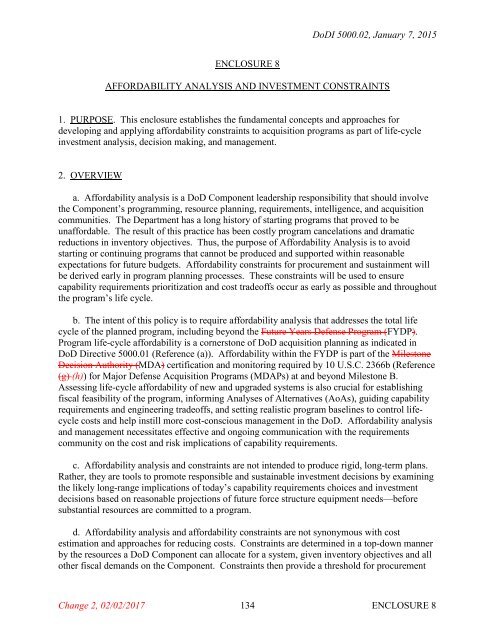Department of Defense INSTRUCTION
x9tnk
x9tnk
Create successful ePaper yourself
Turn your PDF publications into a flip-book with our unique Google optimized e-Paper software.
DoDI 5000.02, January 7, 2015<br />
ENCLOSURE 8<br />
AFFORDABILITY ANALYSIS AND INVESTMENT CONSTRAINTS<br />
1. PURPOSE. This enclosure establishes the fundamental concepts and approaches for<br />
developing and applying affordability constraints to acquisition programs as part <strong>of</strong> life-cycle<br />
investment analysis, decision making, and management.<br />
2. OVERVIEW<br />
a. Affordability analysis is a DoD Component leadership responsibility that should involve<br />
the Component’s programming, resource planning, requirements, intelligence, and acquisition<br />
communities. The <strong>Department</strong> has a long history <strong>of</strong> starting programs that proved to be<br />
unaffordable. The result <strong>of</strong> this practice has been costly program cancelations and dramatic<br />
reductions in inventory objectives. Thus, the purpose <strong>of</strong> Affordability Analysis is to avoid<br />
starting or continuing programs that cannot be produced and supported within reasonable<br />
expectations for future budgets. Affordability constraints for procurement and sustainment will<br />
be derived early in program planning processes. These constraints will be used to ensure<br />
capability requirements prioritization and cost trade<strong>of</strong>fs occur as early as possible and throughout<br />
the program’s life cycle.<br />
b. The intent <strong>of</strong> this policy is to require affordability analysis that addresses the total life<br />
cycle <strong>of</strong> the planned program, including beyond the Future Years <strong>Defense</strong> Program (FYDP).<br />
Program life-cycle affordability is a cornerstone <strong>of</strong> DoD acquisition planning as indicated in<br />
DoD Directive 5000.01 (Reference (a)). Affordability within the FYDP is part <strong>of</strong> the Milestone<br />
Decision Authority (MDA) certification and monitoring required by 10 U.S.C. 2366b (Reference<br />
(g) (h)) for Major <strong>Defense</strong> Acquisition Programs (MDAPs) at and beyond Milestone B.<br />
Assessing life-cycle affordability <strong>of</strong> new and upgraded systems is also crucial for establishing<br />
fiscal feasibility <strong>of</strong> the program, informing Analyses <strong>of</strong> Alternatives (AoAs), guiding capability<br />
requirements and engineering trade<strong>of</strong>fs, and setting realistic program baselines to control lifecycle<br />
costs and help instill more cost-conscious management in the DoD. Affordability analysis<br />
and management necessitates effective and ongoing communication with the requirements<br />
community on the cost and risk implications <strong>of</strong> capability requirements.<br />
c. Affordability analysis and constraints are not intended to produce rigid, long-term plans.<br />
Rather, they are tools to promote responsible and sustainable investment decisions by examining<br />
the likely long-range implications <strong>of</strong> today’s capability requirements choices and investment<br />
decisions based on reasonable projections <strong>of</strong> future force structure equipment needs—before<br />
substantial resources are committed to a program.<br />
d. Affordability analysis and affordability constraints are not synonymous with cost<br />
estimation and approaches for reducing costs. Constraints are determined in a top-down manner<br />
by the resources a DoD Component can allocate for a system, given inventory objectives and all<br />
other fiscal demands on the Component. Constraints then provide a threshold for procurement<br />
Change 2, 02/02/2017 134<br />
ENCLOSURE 8


